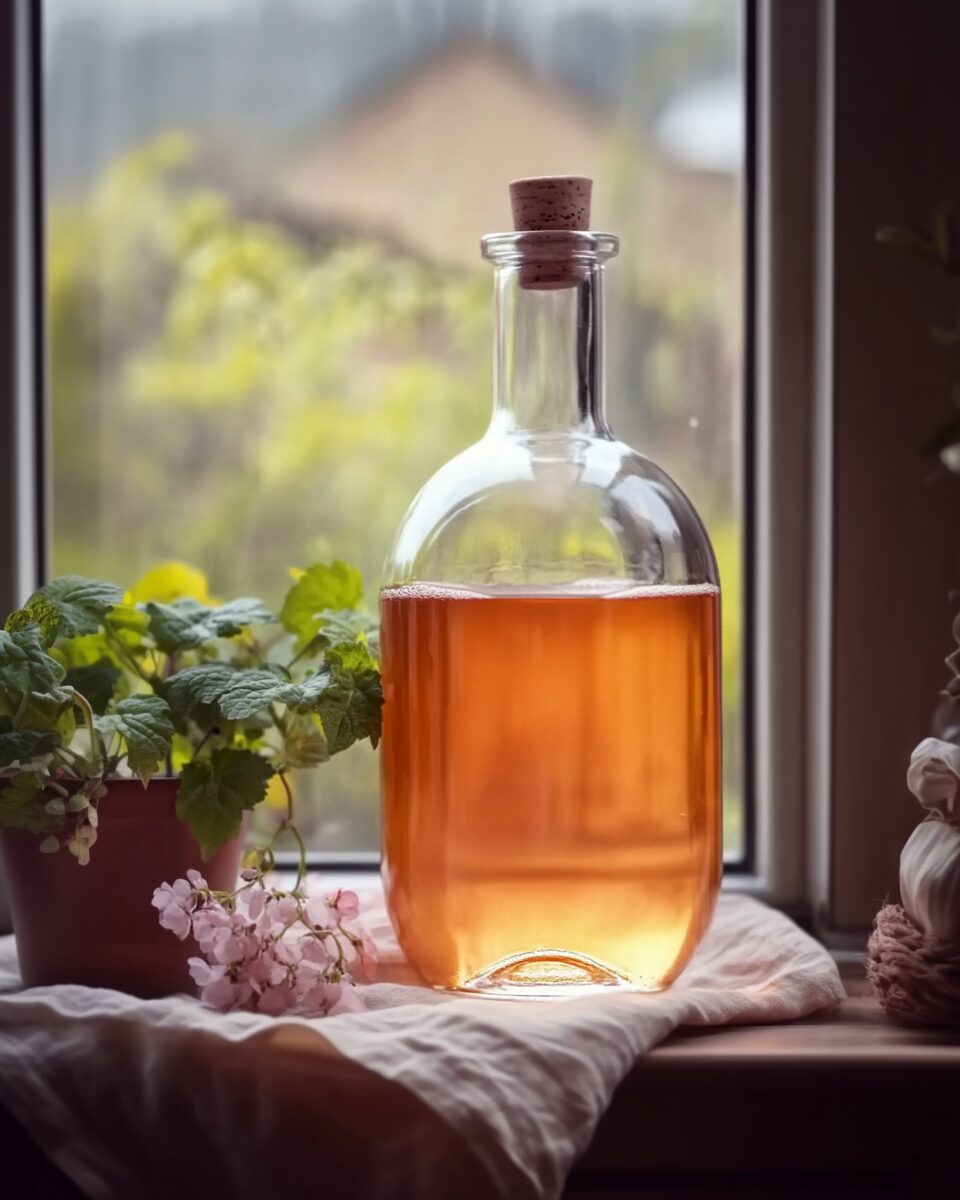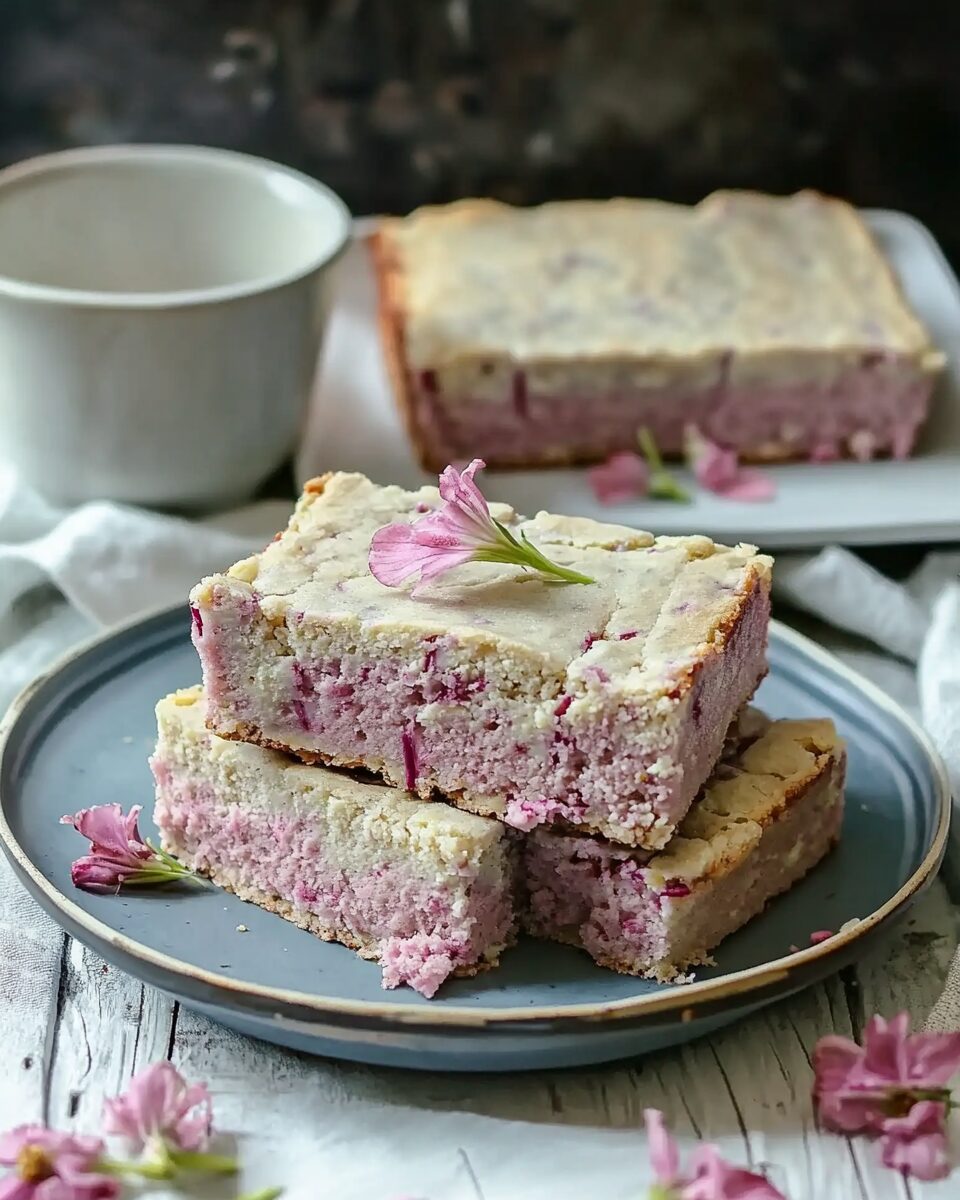Rhubarb wine is a delightful and unique homemade beverage that captures the tart, earthy flavor of rhubarb and transforms it into a refreshing, slightly sweet alcoholic drink. The process of making rhubarb wine involves fermenting rhubarb, sugar, and yeast, allowing the flavors to blend and develop over time. This wine is perfect for a summer gathering or as a special homemade gift. Although the process takes some patience, the result is worth the wait. The tartness of the rhubarb pairs wonderfully with the sweetness of the sugar, creating a crisp and balanced flavor.
Full Recipe:
Ingredients
- 6 cups of chopped rhubarb (about 3-4 stalks)
- 1.5 pounds of granulated sugar
- 1 gallon of water
- 1 teaspoon of pectic enzyme (optional, helps with clearing)
- 1 teaspoon of acid blend (optional, helps balance the acidity)
- 1 Campden tablet (optional, helps kill wild yeast and bacteria)
- 1 packet of wine yeast (preferably champagne yeast)
- 1/4 teaspoon of yeast nutrient (optional)
- 1 lemon, juiced (optional, adds acidity)
Directions
- Prepare the Rhubarb:
- Wash and chop the rhubarb into small pieces. No need to peel it, as the skin contains valuable nutrients and contributes to the overall flavor.
- Boil the Rhubarb:
- In a large pot, bring the water to a boil. Add the chopped rhubarb and let it simmer for 10-15 minutes until it softens and releases its juices.
- Add Sugar and Stir:
- Once the rhubarb has softened, remove the pot from the heat and add the sugar. Stir well until the sugar is completely dissolved.
- Cool the Mixture:
- Allow the rhubarb mixture to cool to room temperature. You can speed up the process by placing the pot in an ice bath or by transferring the mixture to a sanitized container.
- Prepare for Fermentation:
- Once cooled, strain the rhubarb mixture into a fermentation vessel, such as a glass carboy or a food-grade plastic bucket. You can use a fine mesh strainer or cheesecloth to remove the solid rhubarb pieces.
- Add the pectic enzyme, acid blend, lemon juice, and Campden tablet if you’re using them. Stir the mixture thoroughly.
- Add Yeast and Nutrients:
- Sprinkle the yeast over the surface of the rhubarb mixture. If you’re using yeast nutrients, add them as well and stir gently to incorporate.
- Fermentation:
- Seal the fermentation vessel with an airlock and place it in a cool, dark area (around 65-70°F or 18-21°C) for about 7-10 days. During this time, the yeast will ferment the sugars in the rhubarb mixture into alcohol.
- Stir the mixture daily to help with the fermentation process and to release any trapped gases.
- Rack the Wine:
- After 7-10 days, the fermentation should slow down. Siphon or rack the wine into a clean vessel, leaving behind any sediment. If desired, you can repeat this racking process every few weeks until the wine has cleared.
- Age the Wine:
- Once the wine is clear, transfer it to a clean, sanitized bottle and seal it. Let it age for about 6 months to allow the flavors to mature and mellow. Rhubarb wine can be enjoyed young, but it improves with time.
- Enjoy:
- Once the wine has aged, it’s ready to be enjoyed! Serve chilled for a refreshing drink or use it in cocktail recipes.
Nutritional Facts
- Calories: 150-180 per 5 oz serving
- Total Fat: 0g
- Sodium: 5mg
- Carbohydrates: 20g
- Fiber: 0g
- Sugars: 20g
- Protein: 0g
- Alcohol by Volume (ABV): Approximately 12-15%
The History and Tradition of Rhubarb Wine
While rhubarb has been used in various culinary applications for centuries, the tradition of making rhubarb wine is less well-known. Rhubarb is native to Asia and has been cultivated for thousands of years for both medicinal and culinary purposes. The plant’s roots were originally used for their laxative properties, while the stalks were consumed for their tart flavor.
The use of rhubarb in winemaking can be traced back to the early days of European settlers in North America, where they would use the abundant wild rhubarb to create fruit wines. Rhubarb wine became a popular homemade beverage in rural areas during the 18th and 19th centuries, especially when fruits like grapes or apples were not as readily available. Early winemakers would experiment with various fruits and vegetables, including rhubarb, to create drinks that could be enjoyed during the long winters.
Why Make Rhubarb Wine?
Rhubarb wine is a fantastic option for anyone looking to try their hand at winemaking without needing to invest in expensive equipment or hard-to-find ingredients. Making rhubarb wine at home is a cost-effective way to create a unique and flavorful beverage. With just a few basic ingredients—rhubarb, sugar, water, and wine yeast—you can produce a delicious and aromatic wine that has its own distinctive taste.
One of the biggest advantages of rhubarb wine is its versatility. While traditional wines are made from grapes or other fruits, rhubarb offers a more complex flavor profile that is both tart and slightly sweet. This makes rhubarb wine a great option for people who enjoy refreshing drinks with a bit of a tangy kick. The final product can vary depending on the ripeness of the rhubarb, the length of fermentation, and the added ingredients, allowing winemakers to create a personalized beverage that suits their tastes.
The Flavor Profile of Rhubarb Wine
The flavor of rhubarb wine is one of its most striking features. The primary taste comes from the rhubarb itself, which is known for its tart, sour flavor that can range from mildly tangy to intensely acidic, depending on the variety and ripeness of the rhubarb used. This tartness is what sets rhubarb wine apart from other fruit wines and gives it a refreshing quality that is perfect for hot summer days.
When fermented, the rhubarb’s natural acidity transforms, and the resulting wine develops a complex flavor profile. The sweetness from the sugar used in the fermentation process balances out the tartness of the rhubarb, creating a wine that is both crisp and flavorful. Depending on the length of fermentation, the wine can take on a more mellow, smooth taste, or it can retain a pronounced tartness. The wine can also develop hints of floral or herbal notes from the yeast and any added ingredients, such as lemon juice or acid blend.
Rhubarb wine has a light, pale color, typically a soft pink or light amber, which adds to its visual appeal. The drink is often clear and bright, with a slight effervescence if made in the sparkling wine style. The subtle complexity of its flavors makes it an excellent pairing for a variety of dishes, from light appetizers to grilled meats, seafood, and salads.
The Health Benefits of Rhubarb Wine
While rhubarb wine should be enjoyed in moderation, it does offer a few potential health benefits due to the natural properties of rhubarb. Rhubarb is a good source of vitamins and minerals, including vitamin K, vitamin C, calcium, and potassium. It also contains fiber and antioxidants, which can support digestive health and help combat free radicals in the body.
How to Serve Rhubarb Wine
Rhubarb wine is best served chilled, particularly during the warmer months when its crisp and refreshing qualities can be fully appreciated. It is a versatile beverage that can be enjoyed on its own or as part of a larger meal. When serving rhubarb wine, consider pairing it with light, summery dishes such as salads, seafood, or grilled vegetables. Its tart flavor complements the freshness of these foods and enhances the overall dining experience.
Rhubarb wine can also be used in cocktails, either as the base or as an ingredient in a refreshing mix. It pairs particularly well with citrus fruits like oranges and lemons, as their sweetness and acidity balance out the rhubarb’s natural tartness. Try mixing rhubarb wine with soda water for a simple spritz, or add it to a punch for a unique twist on traditional recipes.
For those who enjoy experimenting with cocktails, rhubarb wine can be paired with various spirits, such as gin or rum, to create a refreshing cocktail with a distinctive flavor. You can also use rhubarb wine as a base for sangria, combining it with seasonal fruits and a splash of brandy for a delightful and fruity beverage.
Conclusion
Rhubarb wine offers a unique and delightful alternative to traditional fruit wines. It provides a refreshing, tart, and slightly sweet flavor that can be enjoyed on its own or paired with a variety of dishes. The winemaking process, while simple, requires some patience, but the result is a homemade beverage that is both flavorful and satisfying.








